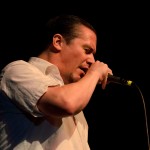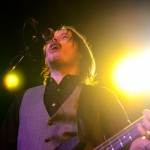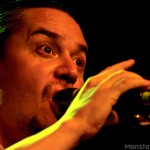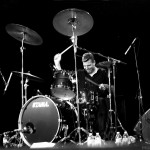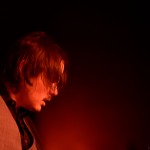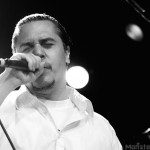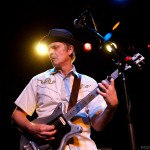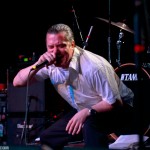Desastre Natural – TOMAHAWK live at The Showbox
The supergroup returns for their first tour in 10 years in support of a brand new album ODDFELLOWS. Here’s a review of the tour opener
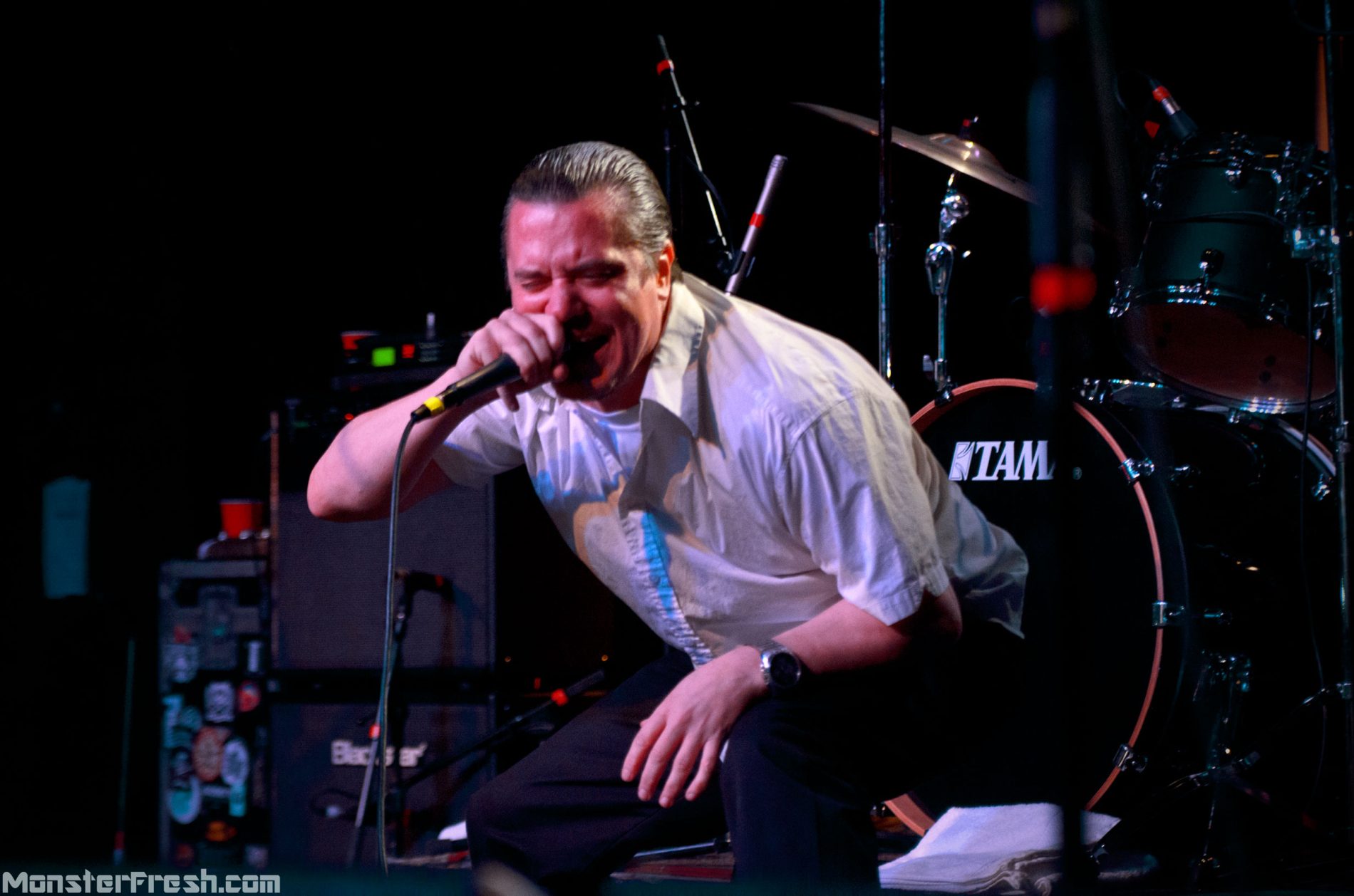
TOMAHAWK
The Showbox
Seattle, Wa
2.12.13
When I sat down against the inside photo pit barricade, the war chant music for the Tomahawk chop was playing. The first thing that I noticed was that the drum kit was different. John Stanier has a fairly recognizable setup when he’s drumming for Battles, which features one absurdly high Zildjian K ride cymbal in the front, that stands out by being fully extended on its stand and appearing to be elevated almost out of reaching distance. Formed by Ian Williams (ex-Don Caballero, Storm & Stress) back in 2002, Battles is a fairly technical experimental outfit, similar to Ian‘s former groups, that relies heavily on the prowess and shifting tempos supplied by Stanier behind the kit. When I shot them back in October of 2011, John was playing a yellow TAMA setup. Also a TAMA, this one was black with a more typical 3-cymbal setup (2 up front and a ride to the side). The different arrangement reflects a slightly different approach for the versatile drummer; this looked like the kit that he was playing as a member of Helmet before the group disbanded in 1998. That was also the same year that both Faith No More and The Cows each broke up. Along with the dissolution of the The Jesus Lizard the following year, these events helped set into motion the formation of TOMAHAWK in 2000. Whatever set their recent reformation, album release, and touring into motion, I’m not sure about, but what I do know is that it’s definitely long overdue.
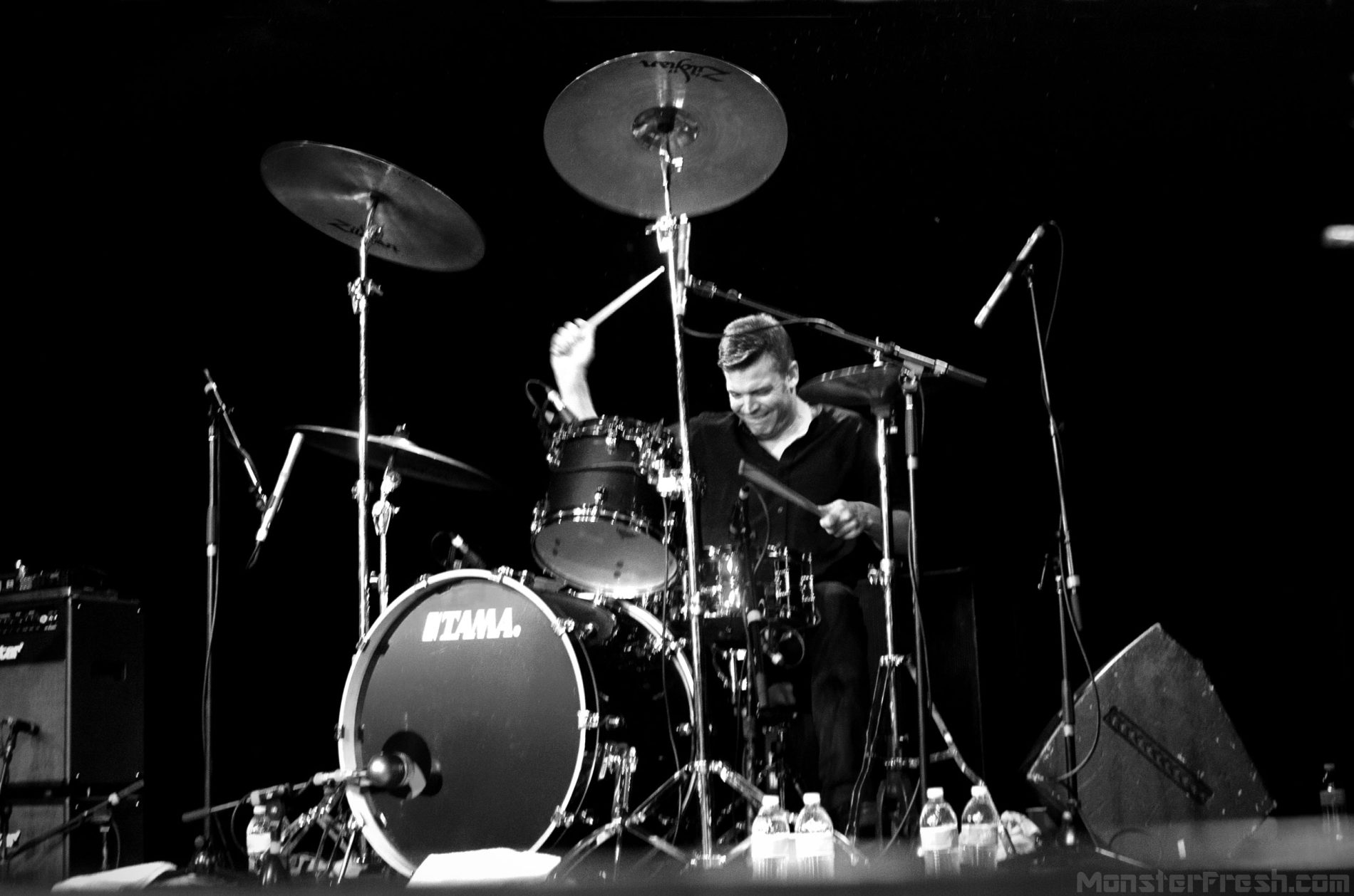
The second thing that I noticed was Mike Patton‘s setup at the front of the stage. There was some kind of makeshift podium that was draped in a black cloth and assembled by stacking, what appeared to be, a few heavy-duty equipment travel cases or monitors on one another. On the very top, rested an open laptop, which was connected to a LIVID OhmRGB midi-controller–Patton would tweak its nobs and faders throughout the show. There was an extension chord hanging down from the top and only one microphone. When I caught the frontman performing with his other big-shot quartet, Fantômas at the exact same venue back in 2005, he had something like 3 separate mic stands and at least one of them had a baby doll head mounted onto it. He also had quite a few more random gadgets to fuck around with. What he’s working with now is likely a consolidated alternative to his previous gear in some ways, but the stripped down setup also felt like a direct reflection of the fact that each Mike Patton project is a very separate entity, in much the same way that BATTLES and HELMET are completely different animals that require variations in Stanier‘s equipment to achieve their respective results. That being said, there is often a familiar pool being drawn from to create these projects. But, fortunately, even when there’s some overlap in talent, the artists working with the vocal wizard are all consistently versatile and drawn to experimentation in their own right.
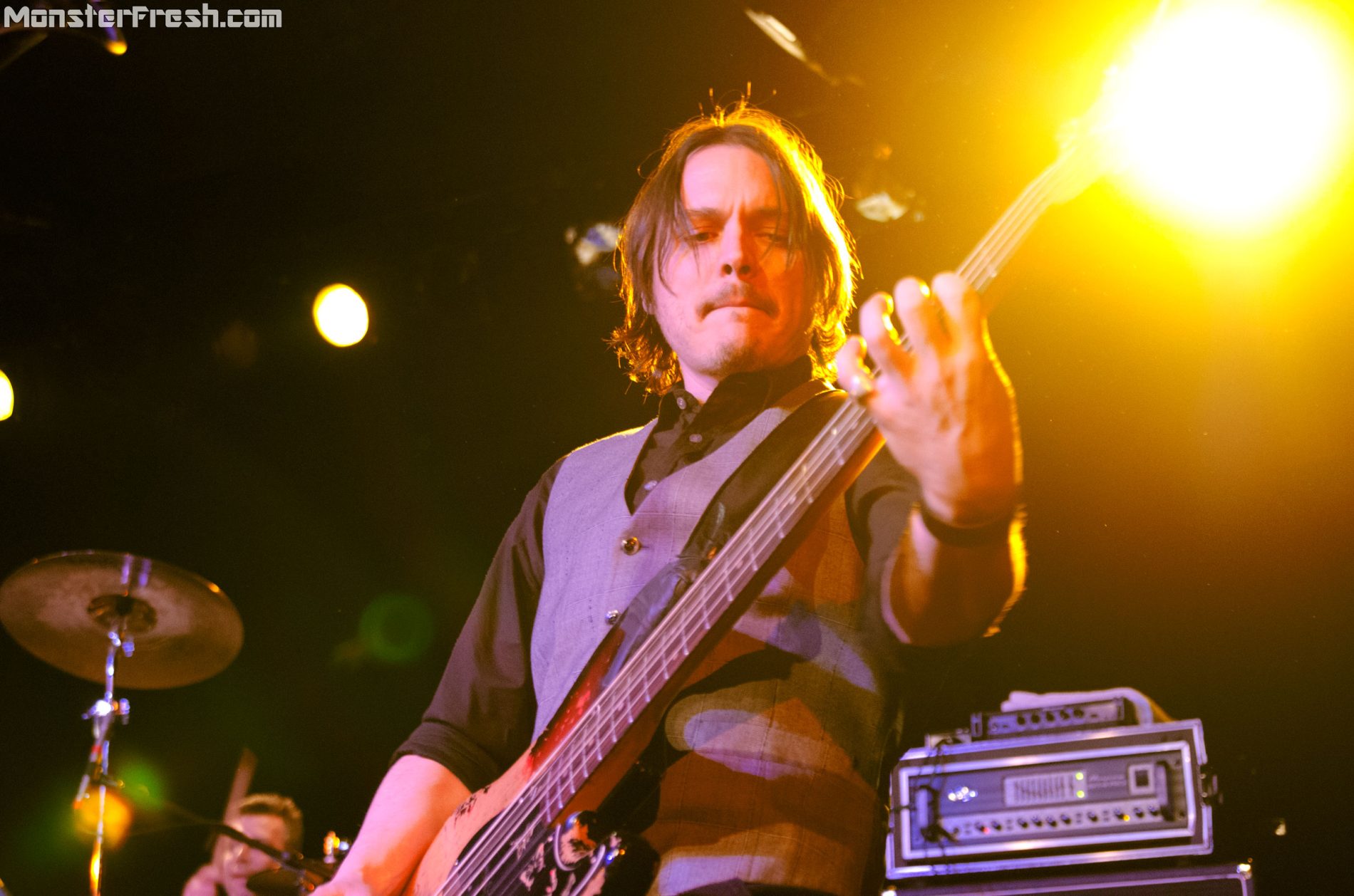
Bassist, Trevor Dunn is the latest addition to Tomahawk, but he’s no stranger to collaboration and, more specifically, no stranger to working closely with Mike Patton. The two have been musical cohorts since forming Mr Bungle with multi-instrumentalist/Mimicry records founder, Trey Spruance (Secret Chiefs 3, temp-Faith No More), back in 1985, when they were all still in high school. In fact, Patton was actually recruited to become the singer for Faith No More after the band’s then-guitarist, Jim Martin, heard the vocalist’s demo work in his first group. The Patton/Dunn project continued to produce material throughout the frontman’s original tenure with Faith No More and even outlasted the band, with Bungle releasing their third and final studio album, California, the year after Faith No More‘s initial 1998 disbandment. The ensuing 11-year FNM hiatus served it’s purpose of allowing Patton to pursue outside projects and, aside from refocusing on Mr Bungle, he also tapped Dunn to play bass for Fantômas–a supergroup that he was forming, which also features Buzz Osborne of Melvins (guitar) and Slayer‘s Dave Lombardo (drums). Created as an outlet for a collection of super heavy, avant garde, highly-experimental, and vocally diverse/challenging compositions that Mike had independently crafted, Fantômas, subsequently, became the catalyst for IPECAC Recordings, which has often been credited as being originally founded with the sole purpose of providing an avenue to release the band’s original full-length.
When I saw that Fantômas show 8 years ago, the multi-talented bassist also performed as the frontman of the first opening act, his avant-jazz outfit, Trevor Dunn’s Trio Convulsant. [Coincidentally, the other opener was the aptly named, shrieking grindcore band, The Locust, of which, vocalist, Justin Pearson’s new band, Retox, was now the opener for this very Tomahawk show.] Dunn has also performed alongside Patton as part of “The Moonchild Trio” backing avant-jazz saxophonist/composer and producer of Mr Bungle‘s self-titled debut, John Zorn. The last time that I saw Dunn live was also at The Showbox, back when he filled in as bassist for Melvins during the set where they performed their classic Whodini album in full, as part of their 25th anniversary tour with Green River. Interestingly Incestuously Incestuoustingly (?) enough, the role that Trevor Dunn is now filling is one that was originally held by Kevin Rutmanis (The Cows, Hepa/Titus), who was also the bassist for Melvins at the time of Tomahawk‘s inception. [Did you catch all of that?]
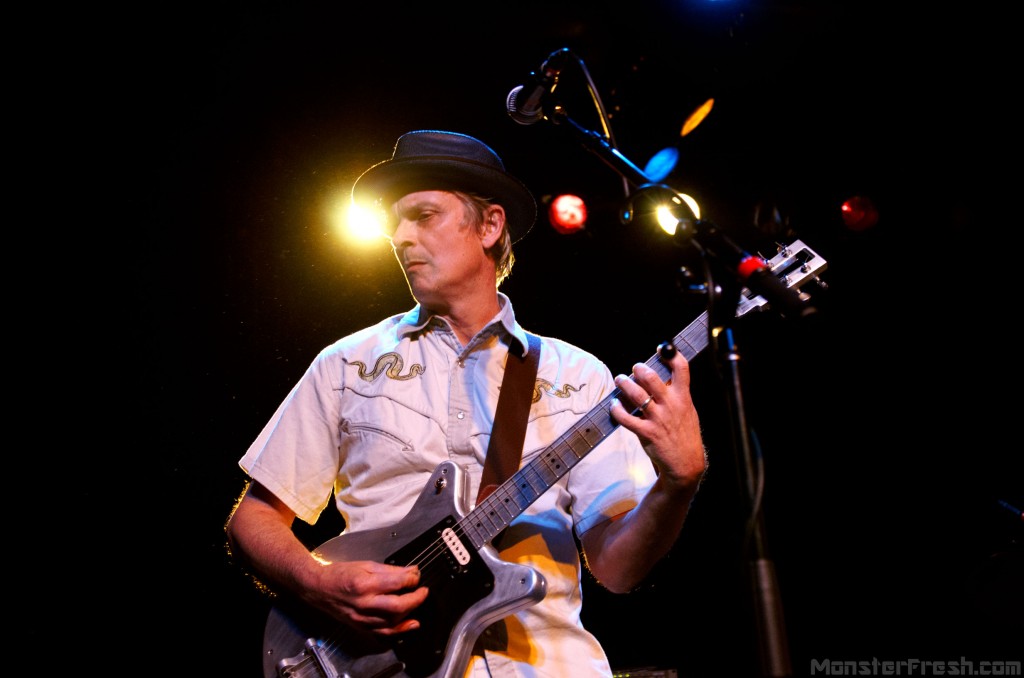
As history tells it, the initial spark for the band was created when Jesus Lizard guitarist, Duane Denison attended a Mr Bungle show in 2000, leading to he and Patton exchanging music and discussing collaboration efforts. From there, Denison recruited Stanier and Patton brought in Rutmanis. The 4-piece released their self-titled debut in 2001 and their follow-up, Mit Gas, in 2003. Both LPs featured a similar sound that seamlessly incorporated distinct elements from each of the members: Rutmanis‘ growling bass sludge; Stanier‘s heavy thumps and cracky breakbeats; Denison‘s plucky spicatto and buzzsaw guitars; and Mike Patton‘s enormous vocal range that shifts from deep croons to operatic highs, while he accents the tracks with keys and samples. As if they were on a mission to earn their band name, Tomahawk released the concept album Anonymous in 2007, taking things in a much different direction by assembling tracks based off of traditional Native American compositions that were heavily researched by Denison while touring Indian reservations with Hank Williams III. The album largely abandoned typical rock song structures, leaning more towards the cinematic work of Fantômas, with ominous soundscapes, slow doomy low-end riffs, stomping tribal beats, and Patton unleashing his gritty demonic vocals like a banshee riding a hell panther, and mixing in everything from steamy ethereal light to laser beams and stormy rainfall. Although Dunn is typically referred to as a replacement for Rutmanis, the former bassist has actually been absent from the group for quite some time and wasn’t even featured on Anonymous at all; the basslines were handled by Denison. While they’ve proven that they can still be fully functional without the assistance of a fourth member in the studio, they haven’t toured in support of an album since Mit Gas. That makes now the first time that they’ve toured together in 10 years, save a handful of Southern dates during Fall of last year that took them through such stops at the Voodoo Music Festival and Fun Fun Fun Fest. This latest tour would launch at The Showbox in Seattle just 2 weeks after the release of their brand new album, Oddfellows.
When they hit the stage, the first song that they tore into was the title/lead-off track from Oddfellows. This song was featured in a youtube video posted by Ipecac Recordings 9 months ago to build anticipation for the new album, which saw it’s release date being pushed back until the end of January. The mere 40 second clip, which provided a glimpse of the infectious, tangled bassline looping and weaving around a heavy deliberate drum beat, was great. And, with a wiry, snakefingered guitar riff whirling dizzyingly like a coked-up dervish over the rhythm section, it demonstrated the ability for the new lineup to really coalesce with one another and was an implication of great things to come. Unfortunately, I’m not sure that another moment on the album ever sounds quite as good to me as that 40 second clip that introduced it. Not unlike a trailer that spoils the film by releasing all of the best jokes in advance, I was hoping that the rest of the material would match that first sample that really intrigued me. Instead, most of it went in a different direction, never sustaining that crazy prog-doom vibe. Also like a number of films, future interactions with the material reveal a fairly solid project, once the prior expectations have died off and the need to judge it within the context and relation to the artist’s previous output is abandoned. With all that being said, this song, and the band in general, sounded amazing right from the jump, and maintained that level of excitement throughout the entire show, with a setlist that was heavily packed with brand new material.

After “Oddfellows” came the first two tracks off of their debut album in chronological order: “Flashback” and “101 North.” Similarly, the first two tracks from Mit Gas, “Birdsong” and “Rape This Day,” were next. These were then followed by “Stone Letter,” the second song, and first single, off of the new album. I’ve heard Stephen Malkmus (Pavement, The Jicks) speak about it, but a lot of people overlook the importance of a setlist. Likewise, the sequencing of album tracks can also be extremely important for setting the tone for a release and, with every one of their albums, Tomahawk has made sure to set them off strong. This 6 song block was not only a reminder of that, but it was also a great opportunity to reflect on the groups output from up until now, as well as to see how effortlessly their new material blended into the rest of the catalog.
That first block was comprised of songs that had a similar aggression, beginning with a sludgy buildup and/or involving quick choppy guitar work–the type of shit that works to launch and then stabilize an LP as it continues to ascend and, ultimately, level out. After that is the point that the show changed up a bit–for the next 10 songs of the standard set, Patton and company stuck to a strict pattern of alternating back and forth between a new track from Oddfellows and more tracks taken from those first 2 releases. “Baby Let’s Play__” is a dreamy Oddfellows crooning number that is like a slightly darker and more James Bond ballad-style version of a song off of the Music To Make Love To Your Old Lady By album from the frontman’s Lovage collaboration with Dan the Automator. “Capt. Midnight,” from Mit Gas, is an intriguing cut that buoys along a shuffling drum machine, contains little blipping samples that sound like electric fireflies, and features verses that are suspended within the Sade range, except for a couple of moments where Stanier unleashes an onslaught on the drums; the voice is raised, and the song rises up like magma, before being quelled back down. “White Hats/Black Hats” cranks the dial back up on the energy, but those 2 songs being played back-to-back worked as a reminder of the range that these guys not only possess, but employ regularly throughout their work. Unfortunately, while it’s to their ultimate benefit, that shifting focus is partially what can make it feel inconsistent through the initial, straight-through listening of an album like Oddfellows. However, it’s also what provides it with it’s real appeal, once you become more acquainted with it. Songs like “A Thousand Eyes,” which is slowly being pullied forward like a conveyor belt through steam, and “Rise Up Dirty Waters,” with its spy groove bassline and Reverend Horton Heat-like chorus–neither of which were played at the show–really provide the new release with a tremendous dimensionality, overall, even if they may not always flow from track to track with a tremendous fluidity, right off the bat, and operate better as individual components of the larger whole.
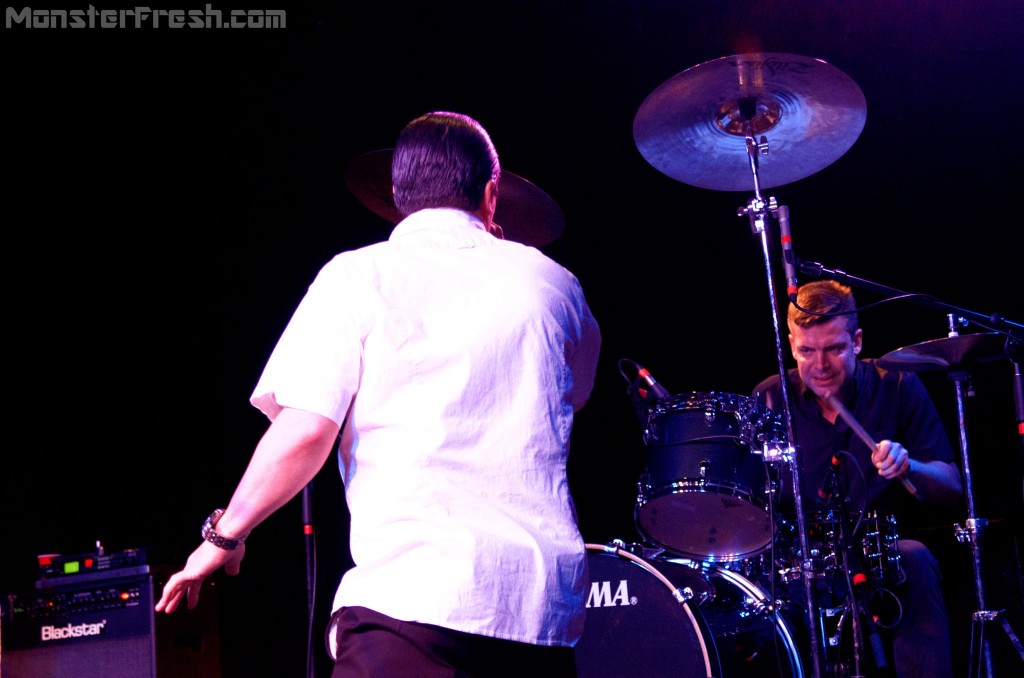
Referring the question to Duane Denison, Mike Patton realized exactly how many years it’s been since the last time that this project has actually toured together. “6?… 10 (years). 10!?” “No, seriously.. 10 years? Noooo… Naaaaaw.” After that, he pointed into the audience and says, “Fuck you, old man! Bullshit!” and then, with comical denial, “I’m still fucking 18 up here! Leave me alone!” That’s when they kicked into their hit “God Hates A Coward” and, while I was no different than the rest of the crowd that was psyched to hear them break out that trademark jam, it did make me wish that they were sporting the cop uniforms from the video that made them look like extras from the 1988 Sean Penn/Robert Duvall inner-city street gang drama, Colors. Patton wasn’t wearing the rigged gas mask microphone contraption either; apparently, I want it all, but I can’t have it. Next came the new steamy apologetic love tune with the “Everybody Knows“-era Leonard Cohen in a Peter Greenway film vibe to it, “I.O.U.” Afterwards, Denison made a comment about it sounding “pretty good” for being the first time that they had ever tried to play the song before. From there, Mike Patton asked the audience if they felt that they should try to play the song again, mentioning that they only see each other every 10 years. He then singled out a member of the crowd, pointing at him and referring to him as Judas Priest vocalist, Rob Halford. “I bet you can rip an ass to shreds, my man.” “Tall bald guy with tattoos in the front row, what am I supposed to do?” “Alright are we playing this song or not? It’s up to you Rob.” The banter continued and, eventually, Denison asked the crowd if they were into the openers, Retox. Then he asks, “How about that hour long, like, marching band? Did you like that too?” I showed up after the Retox set was already in full-swing, which might be why I didn’t catch that reference
They didn’t wind up replaying “I.O.U.” again. Instead, they went into “Rot Gut” (Mit Gas), one of the strongest cuts of the night and one that really allows Patton to demonstrate his vocal range. Midway through, there is a segment where Denison and Dunn wind their spiraling riffs around each other until the guitar begins swirling off like the soundtrack to a haunted, rusty carnival ride. [Other notes that I jotted down for this portion include the terms “tractor beams” and “hatchet murder.”] “Rot Gut” marked the first time in the night that I noticed Mike Patton throwing up any hand signals or gesturing toward any of the other musicians–specifically Stanier. When performing live with Fantômas, there is quite a bit of conducting on his part throughout, but that project involves substantially more shifts in tone and direction, overall. “Rot Gut” is a slightly different beast than much of the other Tomahawk material and is definitely one of their standout tracks, both in live and recorded formats.
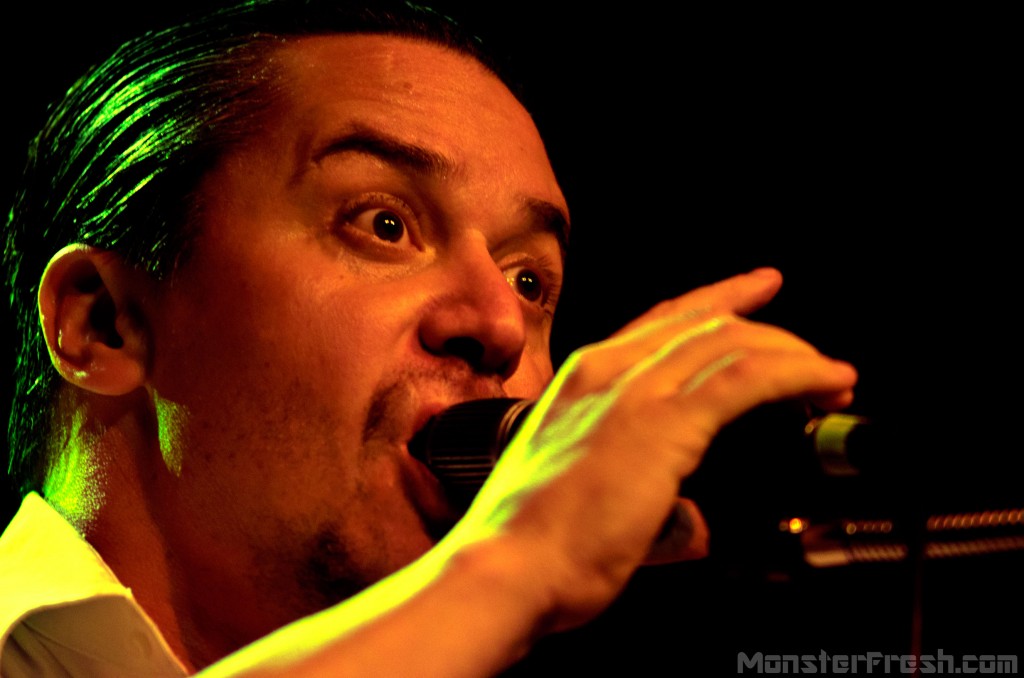
“Southpaw” began with John Stanier powerfully cracking away at the kit and showcases Duane Denison‘s spiraling guitar work and the same ability to slice through tracks like a razor sharp scythe that he repeatedly demonstrated through his work with The Jesus Lizard. “Point and Click” is another amazing, foggy graveyard and tremoring Earth style number from their first release, set apart by Mike Patton‘s manipulation of his voice in ways that display why he’s been hired to provide vocal contributions to videogames like The Darkness (an ancient demonic force), Portal, and Left 4 Dead (infected zombie sounds), as well as the creature voices from the film I Am Legend. Seeing him pull off this type of mind-boggling vocal work is one of the main factors that truly make it worth it to come out to see a band like Tomahawk live. It was another Oddfellows track, “Waratorium,” next, before finishing off the set with the vicious, whipping tornado of chaos, “Laredo.” With the way that he moved around the stage, I couldn’t believe how well Mike Patton‘s slicked back mane stayed so firmly in place. If he ever decided that he wanted it, there is definitely some endorsement money behind whatever hair gel this guy is sporting.
The encore brought the first and only track from Anonymous, “Totem,” and then a cover of the amped up, “Pay To Cum” by DC hardcore punk pioneers, Bad Brains. The band left the stage and the Tomahawk Chop quickly went back to playing over the loud speakers again. People began funneling out of the venue. Then, after a decent portion of the crowd was already out the door, the band returned to pick up their instruments again. By this point, Patton had completely removed his white short-sleeved button-up, exposing what appeared to be a luchador T-shirt underneath. He said something to the effect of, “I figure we’ll send you home in style. Fuck it.” That’s when the place turned into closing time at a honky tonk bar, as the group went into a remarkably faithful rendition of the sombre drinking tune “Just one More” by country music legend George Jones. The show was over, but this last gem was a final reminder of how versatile each and every member of Tomahawk really is. Even knowing how capable Patton is as a vocalist, it was still a bit shocking to hear him deliver such a spot on performance in such an impressive Country Western singing voice, after a show that was… so, very much not that at all.
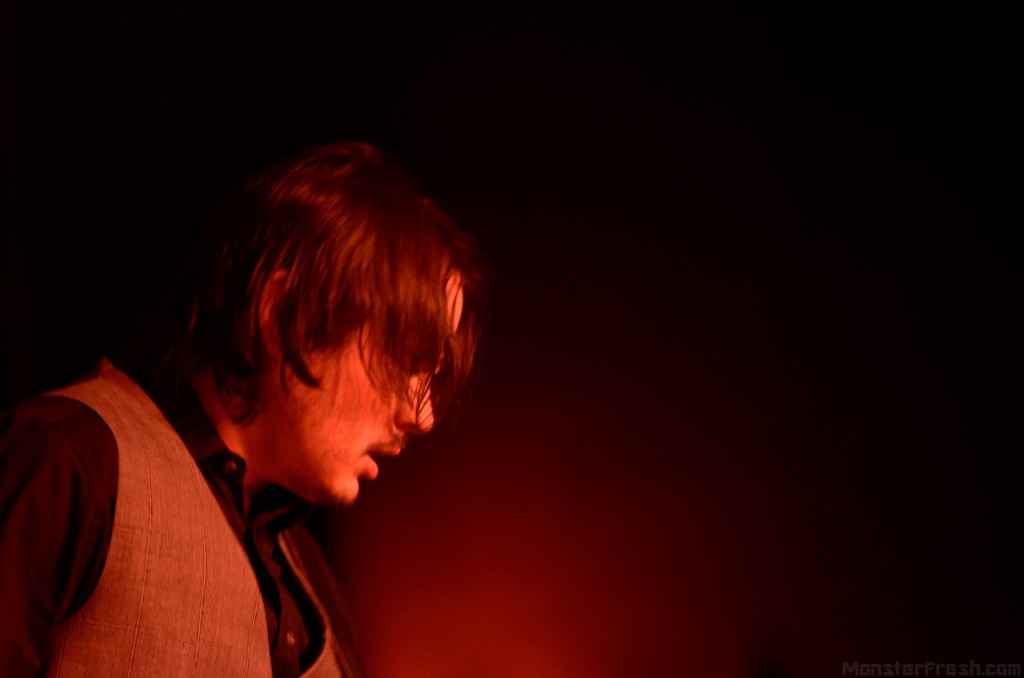
“Supergroups” have a tendency to come across as disjointed, rarely ever allowing the strengths of the individual members to truly shine. Instead, the most cliched elements often find their way into a tune, while very little actual cross-pollination ever really takes place, that could create anything new and inspiring. Tomahawk, on the other hand, have found a way to actually sound like a legitimate group, rather than 4 separate members holding back or waiting their turns to speak. They play with each other, rather than next to each other, but then again, it’s hard to claim this is some one-off operation, after releasing 4 albums, since forming the ensemble a full 12 years ago. As a unit, they collide through some form of alchemy that allows them to produce music that shifts from sludgy to gaseous, ice-pick sharp to solid concrete. It’s brutal, melodic, and scalding, often within the same song, and witnessing them operate as a live unit, not only increases my respect for the project, but also for their new material, as well. [Giving it quite a few more listens, while writing this review, didn’t hurt the cause, either.] Their new work fits firmly into their catalog and, while having new material provides an obvious spark that helps to rejuvenate the project, the method behind the recordings adds to that new sense of vitality even further. Besides losing Rutmanis, the Anonymous recording sessions also suffered from Denison and Stanier‘s need to ship off the recordings across country from Nasvhille to Mike Patton in California. Oddfellows, on the other hand, involved all 4 members recording together live in a studio, which contributes both to the sound and to their connection as a live unit.
I’ve always been more partial to the left-field and “weirder” Patton/Dunn shit, along the lines of Mr Bungle and Fantômas. I also love Battles and the variety of transitions in style and tempo that they explore. When listening to Oddfellows, I felt that there were some moments that leaned more in the Faith No More direction, which simply isn’t as intriguing to me as an individual, but, if anything, this actually appears to be more of a Duane Denison project than anything. Fantômas, on the other hand, is far more of a noise heavy, cinematic entity–they even released an entire album comprised of interpretations from songs off of film soundtracks, many of which were horror movies. With that group, Patton signals his crew on stage like a conductor, directing them through constant transitions, both murky and abrupt, and through dark, demonic rapids. That’s kind of my jam; I could watch an entire show of mind-bending vocal contortion.
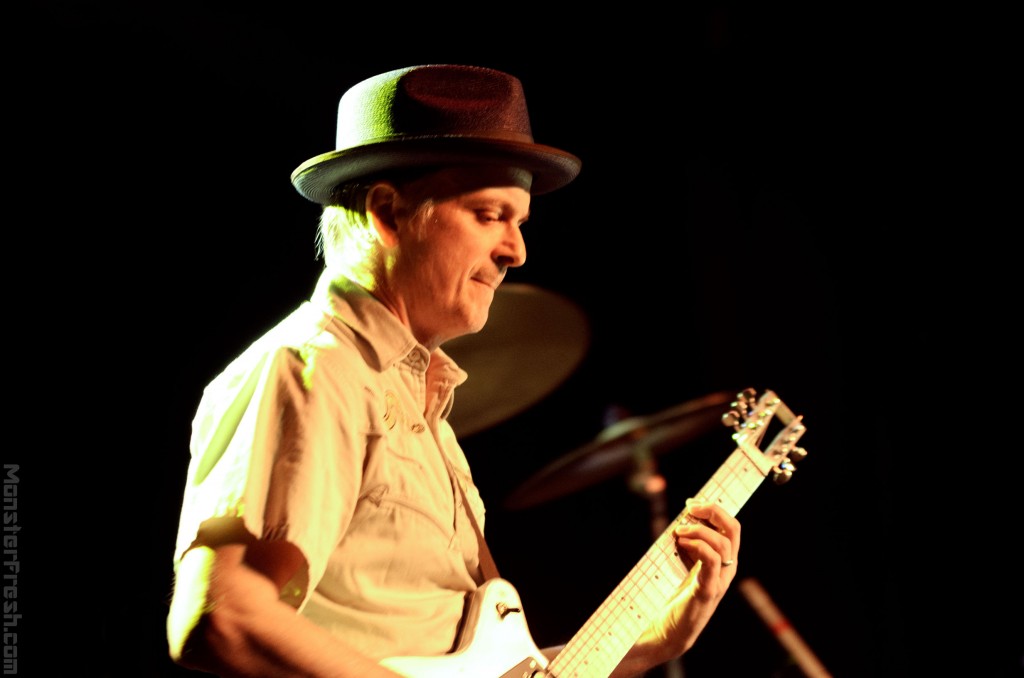
But Tomahawk is more of a straight ahead rock group and, although Denison has some very impressive chops; his guitar work emulating a fully-armed fighter jet prone to daring aerial maneuvers and the deployment of an explosive heat-seeking arsenal; the band is, collectively, still pumping out some fairly straight forward rock tunes. Or, at the very least, that’s how I was hearing some of it at first. The reality is that, while their songs may not be as overtly avant-garde, experimental, or revolutionary as some of the members’ other projects, from a structural perspective, they are still packed with plenty of subtle variations that add an incredible amount of dimensionality to them, overall. It can actually be a lot easier to digest something that is considered more difficult to immediately process, because you can simply toss your mind into the abyss; submerged in the intensity and/or chaos, you can swim your way to the top and ride it out on a broken raft plank, like a boss. Some of Tomahawk‘s music can be just as affective, while operating like the inverse. With the music moving, albeit aggressively, through its designated lane, it’s more unexpected when you find your head being pushed underwater or realize that your leg has been absorbed by a whirlpool and sucked through to another dimension. Almost ironically, the manner of changes in Tomahawk‘s work has made it feel more static to me, in some ways, because, instead of being all out-wacky from out of the gate and in all directions, there are still the obvious straight ahead riffs and vocals regularly popping in and directing the whole thing. But if you sit with these songs for just a little while and give them time, you may notice that they’re getting deeper, the bottom is falling out, and valves crack, unleashing a dose of disorienting knockout gas. Gremlins crawl out of the walls and the paint bubbles up. A giant buzzsaw cuts through the ceiling and blowguns riddle the wall with darts. You may enjoy these rock tunes as they are from the first listen, but things definitely get more interesting with each repeated run through, as certain elements begin to unveil themselves. These songs are booby trapped. The live show only amplifies these effects
If you get a chance, go see Tomahawk live. If you’re a fan of their work, you’re sure to be pleased with the results and, if you’re undecided, it will likely tip the scales in their favor. If you’ve already given Oddfellows a spin or two, it might not be a bad idea to give it another one. I’m still not 100% sure of my final review on the new album, itself, but I do know that I like it, and I also know that it seems to be getting better with each additional listen. That alone is generally a pretty strong indicator that this might be even more successful of an undertaking than my mind has even begun to process by this point.
